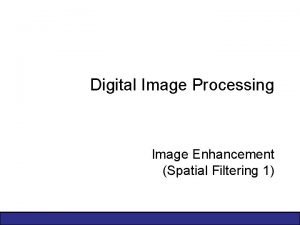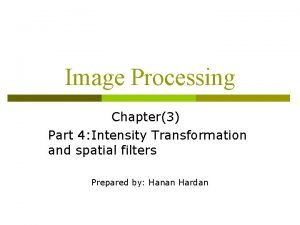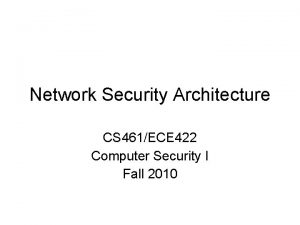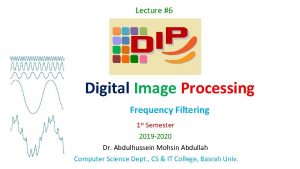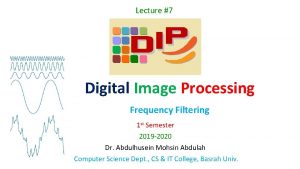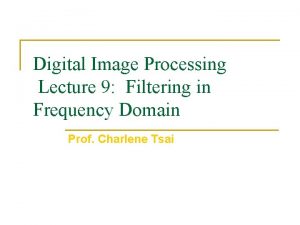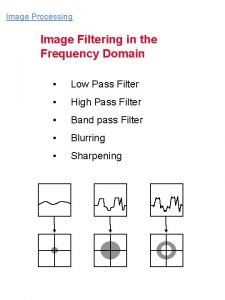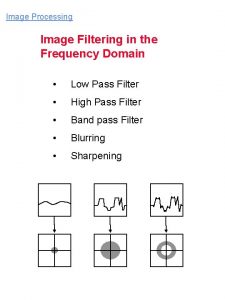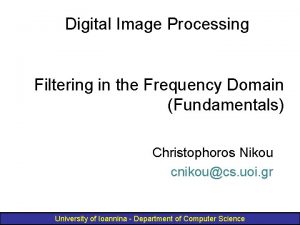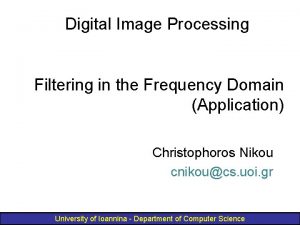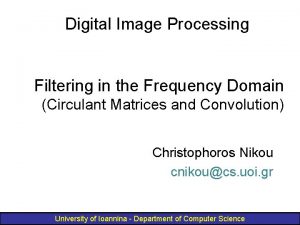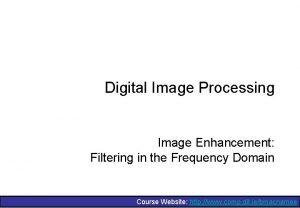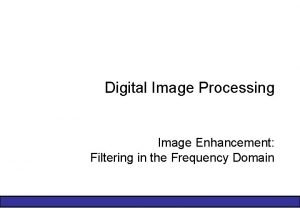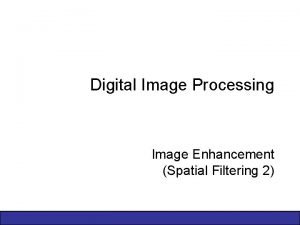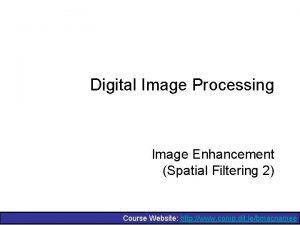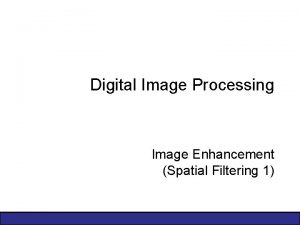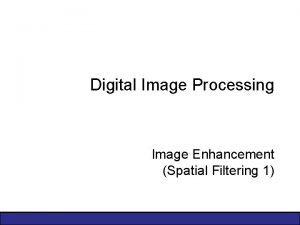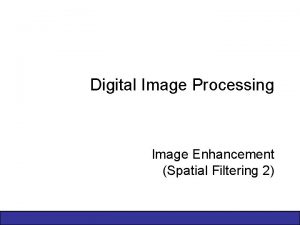Digital Image Processing Lecture 9 Filtering in Frequency





















- Slides: 21

Digital Image Processing Lecture 9: Filtering in Frequency Domain Prof. Charlene Tsai

2 -D Discrete n For an Mx. N matrix n All 1 -D properties transfer into 2 -D Some more properties useful for image processing. n 2

Separability 1 st term n n 2 nd term The 1 st term depends only on x and u, and the 2 nd term depends on y and v. Advantage: computing DFT of all the columns first, then computing the DFT of all the rows of the result. 3

(con’d) n 1 D Fourier pair: (a) Original image (b) DFT of each row of (a), using x&u (c) DFT of each column of (b), using y & v 4

Convolution Theory n Review: q q n We can perform the same operation (convolution) in frequency domain q q n How to convolve an image M with a spatial filter S in spatial domain? If Z, X, Y are the DFT’s of z=x*y, x and y respectively, then Z=X. Y (convolution theory) Pad S with 0, so same size as M; denote the new matrix S’ Perform DFT on M and S’ to obtain F(M) and F(S’) Perform inverse DFT on F(M). F(S’) to get F-1 M*S is F-1 Great saving for a large filter. elt-by-elt product 5

Shifting n n Review: In 1 -D, if multiplying each element xn of vector x by (-1)n we swap the left and right halves of the Fourier transform. In 2 -D, the same principle applies if multiplying all elements xm, n by (-1)m+n before the transform. A B D C C D B A An FFT After shifting 6

Filtering n Our basic model for filtering in the frequency domain is result n Fourier transform of image to be smoothed We’ll briefly discuss 3 types of filters in the order of increasing smoothness: q q q n filter Ideal Butterworth Gaussian Preprocessing: F is shifted so that the DC coefficient is in the center. 7

Ideal Filtering: Low-Pass (ILPF) n The low-frequency components are toward the center. Multiplying the transform by a matrix to remove or minimize the values away from the center. Ideal low-pass matrix H n The inverse DFT of H. F is the smoothed image. n n D(u, v) is distance from the origin of the Fourier transform, shifted to the center 8

Demo An image with its Fourier spectrum. The superimposed circles have radii of 5, 15, 30, 80, and 230 9

Results D=5 D=15 D=30 D=80 D=230 10

Ideal Filtering: High-Pass (IHPF) n Opposite to low-pass filtering: eliminating center and keeping the others. D 0=15 D 0=30 D 0=80 11

Butterworth Filtering: Low-Pass (BLPF) n Unlike ILPF, BLPF does not have a clear cutoff between passed and filtered frequencies. n is the order of the filter 12

Demo n n=2 and D 0 equal the 5 radii D 0=15 D 0=80 D 0=5 D 0=30 D 0=230 13

Butterworth Filtering: High-Pass (BHPF) D 0=15 D 0=30 D 0=80 14

Gaussian Filtering: Low-Pass (GLPF) n n n We mentioned Gaussian once in the section for spatial filtering. Will discuss more in detail in image restoration. Gaussian filter in frequency domain: The inverse is also a Gaussian. We may replace by D 0, which is the cutoff frequency. 15

GLPF (con’d) 16

Demo D 0=5 D 0=15 D 0=80 D 0=30 D 0=230 17

Gaussian Filtering: High-Pass (GHPF) D 0=15 D 0=30 D 0=80 18

In-class Exercise n Q. What is the Fourier transform of the average filtering using the 4 immediate neighbors of point (x, y), but excluding itself? 19

Summary n To perform filtering in frequency domain, do the following steps: q q q n The Fourier transform of the image is shifted, so that the DC coefficient is in the center. (multiply the image by (1)x+y) Create the filter Multiply it by the image transform Invert the result Multiplying the result by (-1)x+y. The relationship between the corresponding highand low-pass filters: 20

21
 In digital image processing
In digital image processing Types of spatial filtering in digital image processing
Types of spatial filtering in digital image processing Histogram processing in digital image processing
Histogram processing in digital image processing Point processing operations
Point processing operations Laplacian filter
Laplacian filter Image processing
Image processing Fractal
Fractal Morphological processing in digital image processing
Morphological processing in digital image processing Linear filtering citra
Linear filtering citra Ingress filtering vs egress filtering
Ingress filtering vs egress filtering Translate
Translate Optimum notch filter in digital image processing
Optimum notch filter in digital image processing Image compression models in digital image processing
Image compression models in digital image processing Key stages in digital image processing
Key stages in digital image processing Variable length coding in digital image processing
Variable length coding in digital image processing Image sharpening in digital image processing
Image sharpening in digital image processing Geometric transformation in digital image processing
Geometric transformation in digital image processing Image formation model in digital image processing ppt
Image formation model in digital image processing ppt Digital image processing
Digital image processing Image geometry in digital image processing
Image geometry in digital image processing Image restoration in digital image processing
Image restoration in digital image processing Image processing lecture notes
Image processing lecture notes
